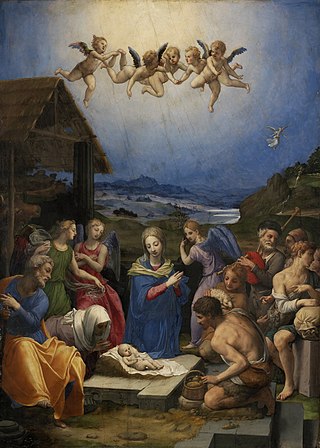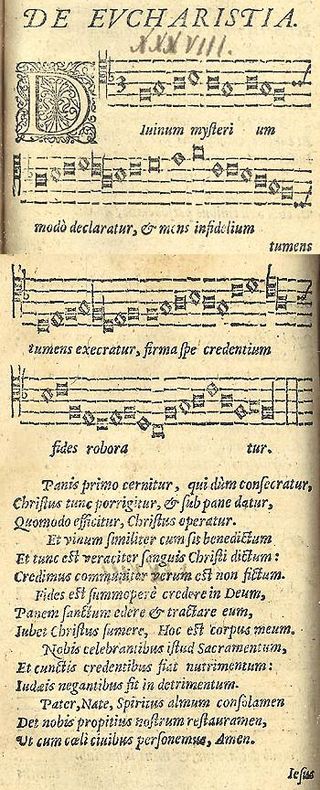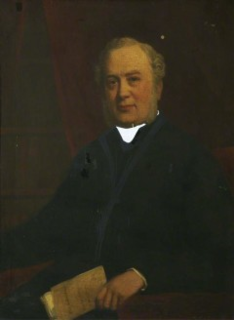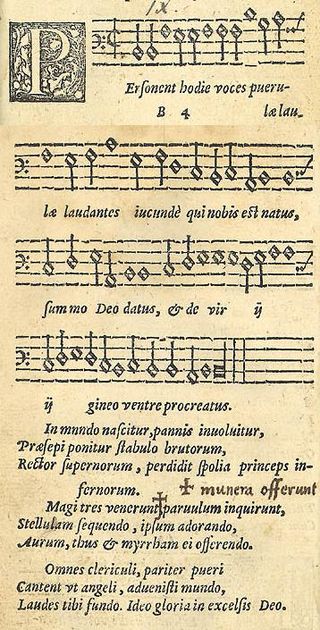
A Christmas carol is a carol on the theme of Christmas, traditionally sung at Christmas itself or during the surrounding Christmas holiday season. The term noel has sometimes been used, especially for carols of French origin. Christmas carols may be regarded as a subset of the broader category of Christmas music.

Orlande de Lassus was a composer of the late Renaissance. The chief representative of the mature polyphonic style in the Franco-Flemish school, Lassus stands with Giovanni Pierluigi da Palestrina and Tomás Luis de Victoria as the leading composers of the later Renaissance. Immensely prolific, his music varies considerably in style and genres, which gave him unprecedented popularity throughout Europe.
A carol is a festive song, generally religious but not necessarily connected with church worship, and sometime accompanied by a dance. A caroller is someone who sings carols, and is said to be carolling.

Michael Praetorius was a German composer, organist, and music theorist. He was one of the most versatile composers of his age, being particularly significant in the development of musical forms based on Protestant hymns.

"Hark! The Herald Angels Sing" is an English Christmas carol that first appeared in 1739 in the collection Hymns and Sacred Poems. The carol, based on Luke 2:14, tells of an angelic chorus singing praises to God. As it is known in the modern era, it features lyrical contributions from Charles Wesley and George Whitefield, two of the founding ministers of Methodism, with music adapted from "Vaterland, in deinen Gauen" by Felix Mendelssohn.
"O Come, All Ye Faithful" is a Christmas carol that has been attributed to various authors, including John Francis Wade (1711–1786), John Reading (1645–1692), King John IV of Portugal (1604–1656), and anonymous Cistercian monks. The earliest printed version is in a book published by Wade. A manuscript by Wade, dating to 1751, is held by Stonyhurst College in Lancashire.

Piae Cantiones ecclesiasticae et scholasticae veterum episcoporum is a collection of late medieval Latin songs first published in 1582. It was compiled by Jacobus Finno, a clergyman who was headmaster of the cathedral school at Turku. Publication was undertaken by Theodoricus Petri Rutha of Nyland, who lived from about 1560 to about 1630. He came from an aristocratic family in Finland, and was educated at Rostock.
Johann Walter, also known as Johann Walther or Johannes Walter was a Lutheran composer and poet during the Reformation period.

"Es ist ein Ros entsprungen" is a Christmas carol and Marian hymn of German origin. It is most commonly translated into English as "Lo, how a rose e'er blooming" and is also called "A Spotless Rose" and "Behold a Rose of Judah". The rose in the German text is a symbolic reference to the Virgin Mary. The hymn makes reference to the Old Testament prophecies of Isaiah, which in Christian interpretation foretell the Incarnation of Christ, and to the Tree of Jesse, a traditional symbol of the lineage of Jesus. Because of its prophetic theme, the hymn is popular during the Christian season of Advent.

"In dulci jubilo" is a traditional Christmas carol. In its original setting, the carol is a macaronic text of German and Latin dating from the Middle Ages. Subsequent translations into English, such as J. M. Neale's arrangement "Good Christian Men, Rejoice" have increased its popularity, and Robert Pearsall's 1837 macaronic translation is a mainstay of the Christmas Nine Lessons and Carols repertoire. J. S. Bach's chorale prelude based on the tune is also a traditional postlude for Christmas services.

"Of the Father's heart begotten" alternatively known as "Of the Father's love begotten" is a doctrinal hymn based on the Latin poem "Corde natus" by the Roman poet Aurelius Prudentius, from his Liber Cathemerinon beginning "Da puer plectrum" which includes the Latin stanzas listed below.

Thomas Helmore was a choirmaster, writer about singing and author and editor of hymns and carols.
Aurora lucis rutilat is the incipit of an Easter hymn of the Latin rite, first recorded in the Frankish Hymnal tradition and preserved in the Benedictine "New Hymnal" . In the numbering introduced by Gneuss (1968), it is no. 41 of the Old Hymnal, and no. 72 of the New Hymnal. The hymn has 12 strophes of 4 verses each as originally recorded;in modern translations it is often reduced to 11 or fewer strophes. The Old High German interlinear version in Bodleian Junius 25 begins Tagarod leohtes lohazit.

"Personent hodie" is a Christmas carol originally published in the 1582 Finnish song book Piae Cantiones, a volume of 74 Medieval songs with Latin texts collected by Jacobus Finno, a Swedish Lutheran cleric, and published by T.P. Rutha. The song book had its origins in the libraries of cathedral song schools, whose repertory had strong links with medieval Prague, where clerical students from Finland and Sweden had studied for generations. A melody found in a 1360 manuscript from the nearby Bavarian city of Moosburg in Germany is highly similar, and it is from this manuscript that the song is usually dated.

"Gelobet seist du, Jesu Christ" is a Lutheran hymn, written by Martin Luther in 1524. It was first published in 1524 in the Eyn geystlich Gesangk Buchleyn. For centuries the chorale has been the prominent hymn (Hauptlied) for Christmas Day in German speaking Lutheranism, but has also been used in different translations internationally. It has appeared in hymnals of various denominations including the Catholic Church.

Singer Pur is a German vocal sextet founded in 1991 by former members of the Regensburger Domspatzen. The five original members were joined by a soprano in 1994. The sextet is focussed on classical music, but who have also performed and recorded traditional folk songs and pop music. Singer Pur have recorded more than 30 CDs. Singer Pur have given concerts and workshops in nearly 60 countries all over the world.

"Vom Himmel hoch, da komm ich her" is a hymn text relating to the Nativity of Jesus, written by Martin Luther in 1534. The hymn is most often sung to the melody, Zahn No. 346, which first appeared in a 1539 songbook and was probably also composed by Luther. This classic Christmas carol remains popular and has inspired many choral and organ works by other composers.

Kindleinwiegen is a Christian Nativity tradition which can be traced back to the Liturgical dramas of the later Medieval period. It is a tradition primarily from the German speaking parts of central Europe which appeared across the region in a variety of forms, chiefly though not exclusively in monasteries and churches. It was at its most widespread between the fifteenth and nineteenth centuries, and survived more strongly in Roman Catholic regions than in those areas that switched to protestantism, following the interventions of Martin Luther and others.

Übers Gebirg Maria geht is a sacred motet by the Renaissance composer and musician Johannes Eccard, who wrote it on a German text by Ludwig Helmbold in two stanzas. The first stanza is a rephrasing of the biblical story of the visit of Mary to Elisabeth, ending in Mary's song of praise known as the Magnificat. The second stanza speaks to present-day listeners, urging them to follow Mary's example and go over the mountains, be inspired, support each other, and sing the Magnificat.
















